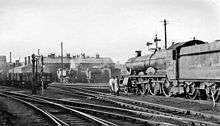Exeter Traction Maintenance Depot
 153382 (in local livery) and other DMUs | |
| Location | |
|---|---|
| Location | Exeter, Devon |
| Coordinates | 50°43′48″N 3°32′43″W / 50.7300°N 3.5452°WCoordinates: 50°43′48″N 3°32′43″W / 50.7300°N 3.5452°W |
| Characteristics | |
| Operator(s) | Great Western Railway |
| Depot code(s) |
|
| History | |
| Opened | 1844 |
| Original | Bristol and Exeter Railway |
| Pre-grouping | GWR |
| Post-grouping | GWR |
Exeter Traction Maintenance Depot (or Exeter TMD) is a railway Traction Maintenance Depot situated in Exeter, Devon, United Kingdom and is next to the city's main St Davids station. The depot is operated by Great Western Railway.
There are 12 roads, the maintenance building itself can hold 2 sets of 2 × 23 m vehicles. Behind a remaining wall from the previous Steam shed is where the Civil Shed is located, and the Premier shed (seldom used) is nearest the station.
History

An engine shed was opened at Exeter by the Bristol and Exeter Railway when it opened the line to here in 1844. A second facility was added a few years later by the South Devon Railway and the two were combined under the Great Western Railway (GWR) in 1876. The Bristol and Exeter had been worked by the GWR until 1849 but then purchased its own locomotives. Temporary workshops for these were built at Exeter but a permanent facility at Bristol was opened in 1851.[1]
When British Railways introduced new shed codes in 1950, Exeter-based locomotives carried an oval cast plate with the code '83C'. The last locomotives based here were sent elsewhere from 14 October 1963, but the shed area was kept as a fueling and stabling point for locomotives and diesel multiple units (DMUs) working in the area.[2] From 29 December 1976 it was recognised as a depot again, even though no locomotives were allocated there at the time, and given a new code 'EX'.[2] The shed was used for many years without a roof, but in 1980 a new covered maintenance area was built.[3] New facilities were provided at the depot in 2011, including a new fueling point, and also jacks so that DMUs do not have to be sent empty to Bristol when they require lifting.[4]
Allocation
The depot's fleet of DMUs at the start of 2010 comprised 74 coaches formed as:[5]
- 6 two-coach Class 142 sets
- 8 two-coach Class 143 sets
- 17 two-coach Class150/2 sets
- 12 single-coach Class 153 sets
The Class 142s had been based here since December 2007, on lease from Northern Rail. They were returned in November and December 2011 after second-hand Class 150/1 sets were received from London Midland.[4] The Class 143s were transferred from St Philips Marsh to Exeter in December 2008, but three of the units worked in the Bristol area each day for several years on services on the Severn Beach Line and the Bristol to Taunton Line, returning to Exeter every other day for servicing.[6]
See also
- Exmouth Junction – the London and South Western Railway shed in Exeter
- List of British Railways shed codes
- List of British Rail TOPS depot codes
References
- ↑ MacDermot, E T (1931). History of the Great Western Railway. 2 (1863-1921) (1 ed.). London: Great Western Railway.
- 1 2 Harris, Roger (1985). The Allocation History of BR Diesels and Electrics (2nd ed.). Bromsgrove: Roger Harris.
- ↑ Kennedy, Rex (1981). Diesels and Electrics on Shed – Western Region. Oxford: Oxford Publishing Company. ISBN 0-86093-042-4.
- 1 2 Miles, Tony (April 2012). "More breathing space on FGW". Modern Railways. Vol. 69 no. 763. Key Publishing. pp. 48–53. ISSN 0026-8356.
- ↑ Marsden, Colin J (2010). Rail Guide (2010 ed.). Hersham: Ian Allan. ISBN 978-0-7110-3457-0.
- ↑ "West Coast dominates timetable changes". Modern Railways. Vol. 65 no. 723. Ian Allan. 2008. pp. 46–50. ISSN 0026-8356.
| Wikimedia Commons has media related to Exeter Traction Maintenance Depot. |